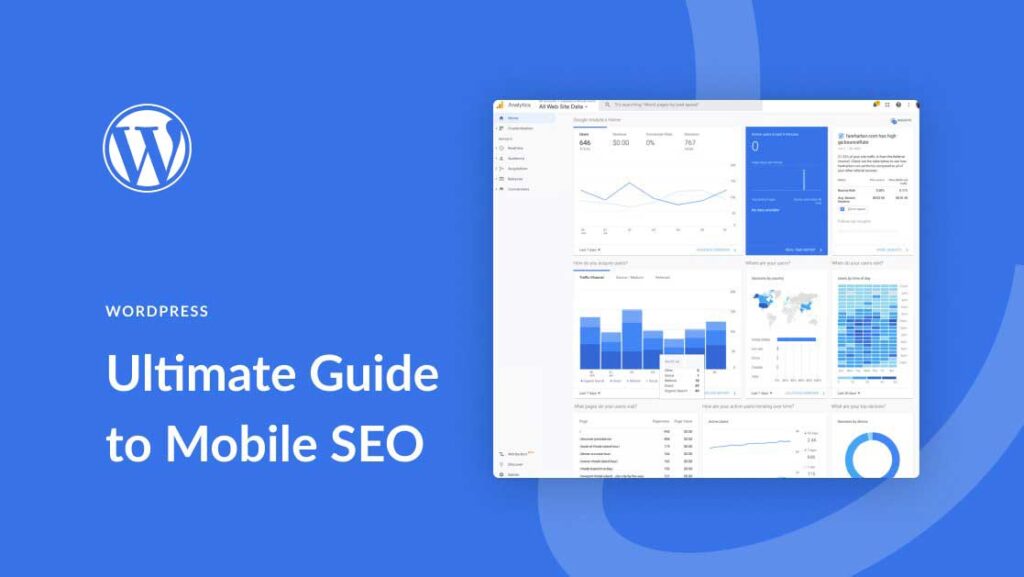
In today’s digital landscape, having a strong online presence is crucial for businesses to thrive. With the increasing use of smartphones and mobile devices, optimizing your website for mobile SEO has become more important than ever. This ultimate guide provides you with valuable insights and practical tips to enhance your website’s visibility and performance on mobile platforms. From responsive design to mobile-friendly content, discover the strategies that will help you reach your target audience and stay ahead in the competitive world of mobile SEO.

What is Mobile SEO
Definition
Mobile SEO refers to the practice of optimizing websites for search engines on mobile devices, such as smartphones and tablets. It involves making various adjustments to improve a website’s visibility and ranking in search engine results pages (SERPs) when accessed from mobile devices. Mobile SEO takes into account the unique characteristics and behaviors of mobile users, ensuring that the website is easily navigable, loads quickly, and provides a seamless user experience on smaller screens.
Importance of Mobile SEO
With the increasing dominance of mobile devices in web browsing, mobile SEO has become crucial for any website’s success. As more and more people use their smartphones to search for information, products, and services, it is essential to ensure that your website appears prominently in mobile search results. In fact, according to Google, the majority of searches are now performed on mobile devices.
Having a mobile-optimized website not only improves your visibility but also enhances user experience, which ultimately leads to higher engagement and conversions. Mobile SEO can drive more organic traffic to your website, increase brand awareness, and contribute to your overall SEO strategy. If your website is not optimized for mobile, you may lose out on potential customers and suffer a decline in search rankings.
Mobile User Behavior
Overview of Mobile Usage
Mobile devices have become an integral part of our daily lives, empowering us with constant access to information and services. Whether it’s checking social media, browsing the internet, or making online purchases, smartphones have revolutionized the way we interact with the digital world. According to Statista, the number of mobile phone users worldwide is expected to surpass 5 billion in 2019.
Impact on Search Behavior
The rise of mobile devices has also affected how people search for information online. Mobile users tend to have different search behavior compared to desktop users. Mobile searches often exhibit higher local intent, with users searching for nearby businesses, directions, and immediate solutions to their needs. Additionally, mobile users have shorter attention spans and expect faster load times and easier navigation on their devices.
Understanding mobile user behavior is crucial for effective mobile SEO. By optimizing your website to align with mobile search behavior, you can better cater to mobile users’ needs, increase engagement, and ultimately enhance your website’s performance in mobile search results.
Mobile-First Indexing
Introduction to Mobile-First Indexing
Mobile-first indexing is an approach employed by search engines, primarily Google, where the mobile version of a website is prioritized for indexing and ranking in search results. In the past, search engines would primarily consider the desktop version of a website when evaluating its relevance and ranking. However, with the dominance of mobile devices, search engines now recognize the necessity of prioritizing mobile versions of websites.
How Mobile-First Indexing Works
With mobile-first indexing, search engine crawlers will primarily look at the mobile version of your website for indexing and ranking purposes. This means that the content, structure, and usability of your mobile site are crucial factors in determining your search visibility. If your mobile version doesn’t have the same level of optimization as your desktop version, it may result in lower rankings and reduced organic visibility.
Optimizing for Mobile-First Indexing
To optimize your website for mobile-first indexing, start by ensuring that your mobile version has equivalent or, ideally, better content compared to your desktop version. Pay attention to mobile-specific elements, such as metadata, headings, and images, and ensure they are properly optimized for mobile viewing.
Additionally, make sure your website is responsive and mobile-friendly, with fast load times, easy navigation, and a design that adapts seamlessly to different screen sizes. Prioritize touch-friendly features and ensure that any interactive elements, such as forms or buttons, are easily accessible and functioning correctly on mobile devices.
Responsive Design and Mobile-Friendliness
Understanding Responsive Design
Responsive design is an approach to web design that aims to provide an optimal viewing experience across a wide range of devices and screen sizes. A responsive website adjusts its layout, images, and content dynamically to fit the screen it is accessed on, eliminating the need for separate mobile and desktop versions.
Benefits of Responsive Design
Implementing responsive design offers several benefits for mobile SEO and user experience. Firstly, it ensures a consistent experience across devices, reducing the risk of content discrepancies between your desktop and mobile versions. Responsive design also eliminates the need for users to manually switch between mobile and desktop URLs, improving user-friendliness and reducing the potential for redirection errors.
From an SEO perspective, responsive design also helps with link building and social sharing, as the URL and content remain consistent across devices. This avoids splitting social signals and backlinks between different versions of your website, ultimately strengthening your website’s authority and enhancing its search rankings.
Best Practices for Mobile-Friendly Websites
To create a mobile-friendly website, incorporate the following best practices:
- Prioritize responsive design: Implement a responsive layout that automatically adjusts to different screen sizes.
- Optimize images: Compress and resize images to reduce load times without sacrificing visual quality.
- Improve mobile site speed: Minimize server response time, leverage browser caching, and reduce resource-heavy elements to enhance mobile site speed.
- Ensure easy navigation: Simplify your website’s navigation menu, prioritize important pages, and use hamburger menus or collapsible sections for better mobile user experience.
- Optimize forms and interactive elements: Make sure that forms and interactive elements on your website are easy to access, fill out, and interact with on mobile devices.
- Test across devices and browsers: Regularly test your website’s performance and appearance on different devices and browsers to ensure consistent functionality and user experience.
By implementing these best practices, you can create a mobile-friendly website that provides a seamless user experience and improves your website’s mobile SEO.

Mobile Website Speed
The Importance of Fast Mobile Websites
Website speed is a critical factor in both user experience and search engine optimization. When it comes to mobile websites, speed is especially important due to the limitations of mobile networks and the impatience of mobile users. Research has shown that mobile users are more likely to abandon websites that take too long to load, leading to higher bounce rates and lower conversions.
Additionally, search engines like Google consider website speed when determining search rankings. In fact, Google has emphasized the importance of mobile website speed by introducing the Page Speed algorithm, which takes mobile load times into account when ranking websites in mobile search results.
Tips for Improving Mobile Website Speed
To improve your mobile website speed, consider implementing the following tips:
- Enable browser caching: Leverage browser caching to store frequently accessed files on users’ devices, reducing the need for repeated downloads.
- Minify and compress files: Minify HTML, CSS, and JavaScript files by removing unnecessary characters and whitespace. Additionally, compress images to reduce file size without compromising image quality.
- Optimize server response time: Reduce server response time by optimizing your website’s code, database queries, and server configurations.
- Use content delivery networks (CDNs): CDNs store your website’s files on multiple servers distributed geographically, delivering content to users from the nearest server and reducing latency.
- Reduce redirects: Minimize the number of redirects on your website, as each redirect adds additional time to load the page.
- Prioritize above-the-fold content: Load essential content, such as headlines and images, before loading additional elements, improving the perceived load time for users.
By optimizing your mobile website speed, you can provide a positive user experience, reduce bounce rates, and improve your website’s visibility and rankings in mobile search results.
Mobile Search Intent and Keywords
Difference in Mobile and Desktop Search Intent
Mobile search intent refers to the primary goal or purpose behind a user’s mobile search query. It is often different from desktop search intent due to the unique characteristics of mobile use cases. Mobile users are often on-the-go, looking for quick answers or immediate solutions to their needs. They may be searching for local businesses, directions, or specific information that satisfies their immediate requirements.
Desktop searches, on the other hand, may involve more research-oriented queries or longer browsing sessions. Desktop users may be more interested in in-depth articles or product comparisons, taking their time to explore various options before making a decision.
Understanding the difference in mobile and desktop search intent is crucial for effective mobile SEO. By aligning your keywords and content with mobile users’ specific needs, you can better meet their expectations, provide relevant information, and increase your chances of attracting and engaging mobile users.
Optimizing Keywords for Mobile Searches
To optimize your keywords for mobile searches, consider the following tips:
- Conduct keyword research: Use keyword research tools to identify mobile-specific keywords that align with your target audience’s search intent on mobile devices.
- Focus on local search: Incorporate local keywords and phrases to target mobile users who are searching for nearby businesses or services.
- Use long-tail keywords: Mobile searches often involve more specific queries, so opt for long-tail keywords that provide more context and precisely match what mobile users are looking for.
- Think voice search: With the rise of voice assistants, optimize your keywords for voice search by using natural language and answering specific questions that mobile users may ask.
- Analyze and refine: Regularly review your keyword performance and analytics, making adjustments based on the data to improve your mobile SEO strategy.
By incorporating mobile-optimized keywords into your content and aligning them with mobile users’ search intent, you can increase your visibility in mobile search results and drive more targeted traffic to your website.

Mobile-Optimized Content
Creating Engaging and Mobile-Friendly Content
Creating engaging and mobile-friendly content is crucial for capturing the attention of mobile users and encouraging them to stay on your website. Mobile users tend to have shorter attention spans and are more likely to skim through content rather than read every word.
To create engaging and mobile-friendly content, follow these tips:
- Use concise and scannable headings: Break up your content with clear and concise headings that capture the main points. This allows mobile users to quickly grasp the content’s structure and find relevant information.
- Keep paragraphs and sentences short: Mobile users prefer shorter paragraphs and sentences as they are easier to read and digest on smaller screens.
- Format content for readability: Use bullet points, numbered lists, and bold text to emphasize key points and make your content more scannable.
- Incorporate relevant visuals: Mobile users are drawn to visuals, so include images, infographics, or videos that enhance your content and make it visually appealing.
- Optimize content for voice search: Consider including natural language and long-tail keywords that align with voice search queries.
- Test readability and responsiveness: Regularly test your content’s readability and appearance on different mobile devices to ensure a positive user experience.
By creating engaging and mobile-friendly content, you can capture and retain the attention of mobile users, encouraging them to explore more of your website and potentially convert.
Understanding the Importance of Visuals
Visuals play a crucial role in mobile SEO and user engagement. Mobile users are highly visual and are more likely to interact with content that includes compelling images, videos, or infographics. Visuals not only capture attention but also enhance the overall user experience and make content easier to understand and digest on smaller screens.
When using visuals, consider the following best practices:
- Optimize image sizes: Compress and resize images to reduce their file size without compromising quality, improving page load times.
- Use descriptive alt text: Ensure that each image has descriptive alt text that accurately describes the image’s content, improving accessibility and providing context for search engines.
- Implement lazy loading: Lazy loading images allows them to load only when they become visible on the user’s screen, reducing initial load times and improving mobile website speed.
- Consider mobile video: Incorporate mobile-friendly videos that are optimized for smaller screens and load quickly to provide valuable information or engage users.
- Test visuals across devices: Regularly test how visuals appear and function on different mobile devices to ensure a consistent user experience.
By using visuals effectively and optimizing them for mobile viewing, you can enhance user engagement, improve the overall user experience, and boost your website’s performance in mobile search results.
Optimizing Content Structure for Mobile
When optimizing content structure for mobile, consider the following tips:
- Use clear and concise headings: Headings should accurately reflect the content they introduce and make it easy for mobile users to navigate through your content.
- Break content into shorter paragraphs: Long paragraphs can be daunting on mobile devices, so break them up into shorter ones to improve readability and scannability.
- Use bullet points and numbered lists: Bullet points and numbered lists make content more digestible and appealing to mobile users who prefer quick information.
- Highlight key points: Use bold or italics to emphasize important information or key takeaways, making them more easily identifiable on mobile screens.
- Implement a table of contents: For longer-form content, consider incorporating a table of contents at the top of the page to allow mobile users to quickly jump to relevant sections.
- Use anchor links for in-page navigation: When your content has multiple sections, provide anchor links at the top that allow users to jump to specific sections within the same page easily.
By optimizing content structure for mobile devices, you can improve the user experience, keep mobile users engaged, and increase the likelihood of conversions.
Local Mobile SEO
Introduction to Local Mobile SEO
Local mobile SEO focuses on optimizing your website and online presence to attract customers from specific geographic areas. As mobile users often search for businesses or services nearby, it is essential to have a strong local mobile SEO strategy to improve your visibility in local search results and attract relevant local traffic.
Optimizing for Local Mobile Search
To optimize your website for local mobile search, consider the following tips:
- Optimize your Google My Business (GMB) profile: Claim and optimize your GMB profile with accurate and up-to-date information, including your business name, address, phone number, and website URL.
- Include local keywords and phrases: Incorporate location-specific keywords and phrases throughout your website, including in your titles, meta descriptions, headings, and content.
- Consistent NAP information: Ensure that your business Name, Address, and Phone number (NAP) are consistent across your website, GMB profile, and any other online directories or listings where your business is mentioned.
- Acquire local backlinks: Seek local backlinks from reputable and relevant sources such as local directories, industry associations, local news outlets, or local influencers.
- Encourage customer reviews: Encourage your customers to leave reviews on your GMB profile and other review platforms. Positive reviews not only improve your visibility but also contribute to building trust and credibility.
- Create location-specific landing pages: If you have multiple locations, create dedicated landing pages for each location and optimize them with relevant location-specific information.
By optimizing for local mobile search, you can improve your visibility in local search results, attract more local customers, and increase foot traffic to your physical store or business.
Utilizing Google My Business
Google My Business (GMB) is an essential tool for local mobile SEO. It provides a platform for businesses to manage their online presence on Google, including Google Search and Google Maps. By claiming and optimizing your GMB profile, you can significantly increase your local visibility and improve your chances of attracting relevant local traffic.
To optimize your GMB profile, follow these tips:
- Provide accurate and complete information: Ensure that your business name, address, phone number, and website URL are all accurate and up-to-date. Double-check for any errors or inconsistencies.
- Choose relevant categories: Select the most appropriate categories that describe your business. Use specific categories that match the products or services you offer.
- Craft an informative business description: Write a concise and engaging business description that accurately reflects your brand and what you offer. Include relevant keywords and unique selling points.
- Add photos and videos: Include high-quality, visually appealing photos and videos that showcase your business, products, or services. Make sure they accurately represent your brand and entice potential customers.
- Encourage customer reviews: Regularly monitor and respond to customer reviews on your GMB profile. Encourage satisfied customers to leave positive reviews, as they can help improve your visibility and credibility.
- Use Google Posts: Take advantage of the Google Posts feature to share updates, offers, or upcoming events related to your business. This can help attract attention and engagement from potential customers.
By fully utilizing Google My Business, you can optimize your local mobile SEO, increase your visibility in local search results, and effectively connect with your target audience.

Mobile Link Building
Importance of Mobile Link Building
Link building is a crucial component of SEO, and it plays an equally important role in mobile SEO. By acquiring high-quality and relevant backlinks to your mobile website, you can improve its authority, visibility, and overall performance in mobile search results.
Mobile link building is essential for several reasons:
- Mobile-first indexing: With search engines prioritizing mobile versions of websites for indexing and ranking, mobile links play a significant role in determining the authority and relevance of your website in mobile search results.
- User experience and engagement: Linking to authoritative and relevant sources can enhance the user experience on your mobile website, providing users with additional valuable information and improving engagement.
- Local link building: Acquiring local backlinks from reputable local sources can significantly boost your local mobile SEO efforts, especially if you have a local business targeting a specific geographic area.
Effective Link Building Strategies for Mobile
To implement effective link building strategies for mobile, consider the following tips:
- Build relationships with local influencers: Connect with influential bloggers, social media influencers, or local organizations within your target industry or location. Encourage them to link to your mobile website, share your content, or collaborate on relevant projects.
- Create shareable content: Develop high-quality and shareable content that provides unique value to your target audience. Mobile users are more likely to share content that is entertaining, informative, or visually appealing, increasing the chances of acquiring backlinks.
- Guest blogging and content contribution: Seek opportunities to contribute guest blog posts or articles to authoritative websites or industry publications. Include relevant backlinks to your mobile website within the content or author bio, enhancing your website’s authority and visibility.
- Participate in local directories and listings: Submit your mobile website to relevant local directories and listings, including local business directories, industry-specific directories, and online review platforms.
- Leverage social media: Share your mobile website content on social media platforms and encourage others to link to it or share it with their followers. Engage with your audience and respond to comments or messages to foster relationships and potential link opportunities.
- Monitor and reclaim broken links: Regularly monitor your backlinks and identify any broken or non-functional links. Reach out to the linking website and request a link update or replacement, providing them with the correct URL or content.
By implementing these effective link building strategies for mobile, you can strengthen your website’s authority, improve visibility, and drive targeted traffic to your mobile website.
Mobile SEO Tools and Resources
Must-Have Mobile SEO Tools
To effectively optimize your website for mobile, it’s beneficial to use various mobile SEO tools. These tools can provide insights and data to help you make informed decisions about your mobile SEO strategy. Some must-have mobile SEO tools include:
- Google PageSpeed Insights: This tool analyzes your mobile website’s performance and provides suggestions for improving its speed and user experience.
- Google Mobile-Friendly Test: This tool assesses your website’s mobile-friendliness and identifies potential issues that might impact your mobile SEO.
- Google Search Console: Search Console offers valuable data and insights about your website’s performance in mobile search results, including traffic, ranking, and indexing information.
- SEMrush Mobile SEO Toolkit: SEMrush provides a suite of tools dedicated to mobile SEO, including mobile keyword research, mobile rank tracking, and mobile traffic analysis.
- MobileMoxie SERPerator: This tool allows you to view search results as they appear on different mobile devices and screen sizes, providing critical insights into mobile search visibility.
- Mobile-friendly testing tools: There are several online tools available specifically for testing the mobile-friendliness of websites, such as BrowserStack and Responsive Design Checker.
By utilizing these must-have mobile SEO tools, you can analyze and optimize your mobile website effectively, leading to improved visibility, user experience, and overall mobile SEO performance.
Useful Mobile SEO Resources
To further enhance your understanding of mobile SEO and stay up-to-date with the latest industry trends and best practices, consider exploring the following mobile SEO resources:
- Google Webmasters Mobile SEO Guide: Google provides a comprehensive guide that covers various aspects of mobile SEO, including mobile-friendly design, mobile UX, and mobile site speed.
- Moz Mobile SEO Learning Center: Moz offers an extensive learning center that features articles, guides, and videos specifically focused on mobile SEO and best practices.
- Search Engine Land Mobile SEO: Search Engine Land provides a dedicated section for mobile SEO, with articles, case studies, and news related to mobile search.
- Mobile Marketing Association (MMA): The MMA is a global trade association that offers resources, reports, and research related to mobile marketing and mobile SEO.
- Google Mobile Search Documentation: Google’s official documentation provides in-depth information about various topics related to mobile search, including mobile-first indexing, mobile usability, and structured data for mobile.
- MobileMoxie Mobile SEO Blog: MobileMoxie’s blog offers valuable insights and best practices for mobile SEO, covering topics such as mobile SERP features, mobile visibility, and mobile UX.
By utilizing these useful mobile SEO resources, you can gain valuable knowledge, stay informed about industry updates, and continuously optimize your mobile website to stay ahead of the game.
In conclusion, mobile SEO is crucial in today’s digital landscape dominated by mobile devices. Understanding mobile user behavior, optimizing for mobile-first indexing, prioritizing responsive design and mobile-friendliness, and focusing on mobile-specific factors such as speed, search intent, keywords, content, and local SEO are key to successful mobile optimization. By utilizing the right tools and resources, implementing best practices, and continuously refining your mobile SEO strategy, you can improve your visibility in mobile search results, deliver an exceptional user experience, and drive targeted traffic to your mobile website.








